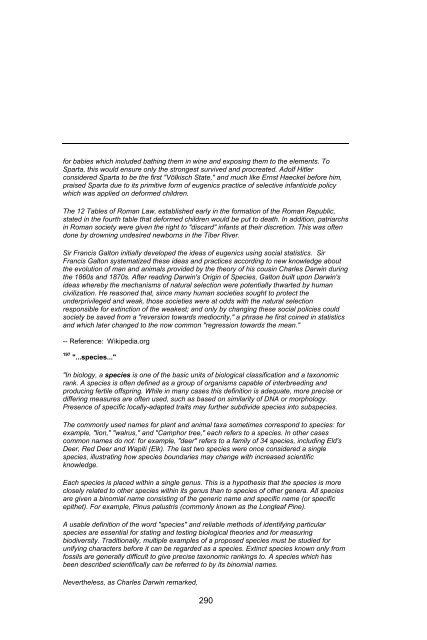ALIEN INTERVIEW - THE NEW EARTH - Earth Changes and The ...
ALIEN INTERVIEW - THE NEW EARTH - Earth Changes and The ...
ALIEN INTERVIEW - THE NEW EARTH - Earth Changes and The ...
You also want an ePaper? Increase the reach of your titles
YUMPU automatically turns print PDFs into web optimized ePapers that Google loves.
for babies which included bathing them in wine <strong>and</strong> exposing them to the elements. To<br />
Sparta, this would ensure only the strongest survived <strong>and</strong> procreated. Adolf Hitler<br />
considered Sparta to be the first "Völkisch State," <strong>and</strong> much like Ernst Haeckel before him,<br />
praised Sparta due to its primitive form of eugenics practice of selective infanticide policy<br />
which was applied on deformed children.<br />
<strong>The</strong> 12 Tables of Roman Law, established early in the formation of the Roman Republic,<br />
stated in the fourth table that deformed children would be put to death. In addition, patriarchs<br />
in Roman society were given the right to "discard" infants at their discretion. This was often<br />
done by drowning undesired newborns in the Tiber River.<br />
Sir Francis Galton initially developed the ideas of eugenics using social statistics. Sir<br />
Francis Galton systematized these ideas <strong>and</strong> practices according to new knowledge about<br />
the evolution of man <strong>and</strong> animals provided by the theory of his cousin Charles Darwin during<br />
the 1860s <strong>and</strong> 1870s. After reading Darwin's Origin of Species, Galton built upon Darwin's<br />
ideas whereby the mechanisms of natural selection were potentially thwarted by human<br />
civilization. He reasoned that, since many human societies sought to protect the<br />
underprivileged <strong>and</strong> weak, those societies were at odds with the natural selection<br />
responsible for extinction of the weakest; <strong>and</strong> only by changing these social policies could<br />
society be saved from a "reversion towards mediocrity," a phrase he first coined in statistics<br />
<strong>and</strong> which later changed to the now common "regression towards the mean."<br />
-- Reference: Wikipedia.org<br />
197 "...species..."<br />
"In biology, a species is one of the basic units of biological classification <strong>and</strong> a taxonomic<br />
rank. A species is often defined as a group of organisms capable of interbreeding <strong>and</strong><br />
producing fertile offspring. While in many cases this definition is adequate, more precise or<br />
differing measures are often used, such as based on similarity of DNA or morphology.<br />
Presence of specific locally-adapted traits may further subdivide species into subspecies.<br />
<strong>The</strong> commonly used names for plant <strong>and</strong> animal taxa sometimes correspond to species: for<br />
example, "lion," "walrus," <strong>and</strong> "Camphor tree," each refers to a species. In other cases<br />
common names do not: for example, "deer" refers to a family of 34 species, including Eld's<br />
Deer, Red Deer <strong>and</strong> Wapiti (Elk). <strong>The</strong> last two species were once considered a single<br />
species, illustrating how species boundaries may change with increased scientific<br />
knowledge.<br />
Each species is placed within a single genus. This is a hypothesis that the species is more<br />
closely related to other species within its genus than to species of other genera. All species<br />
are given a binomial name consisting of the generic name <strong>and</strong> specific name (or specific<br />
epithet). For example, Pinus palustris (commonly known as the Longleaf Pine).<br />
A usable definition of the word "species" <strong>and</strong> reliable methods of identifying particular<br />
species are essential for stating <strong>and</strong> testing biological theories <strong>and</strong> for measuring<br />
biodiversity. Traditionally, multiple examples of a proposed species must be studied for<br />
unifying characters before it can be regarded as a species. Extinct species known only from<br />
fossils are generally difficult to give precise taxonomic rankings to. A species which has<br />
been described scientifically can be referred to by its binomial names.<br />
Nevertheless, as Charles Darwin remarked,<br />
290





